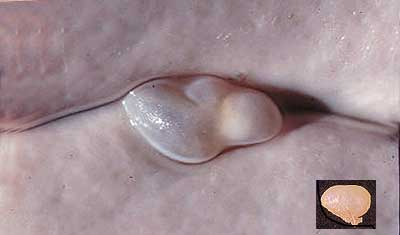Parasites and Diseases
Liver Tapeworm Cysts
A Field Guide
TO COMMON WILDLIFE DISEASES
AND PARASITES IN ALASKA
LIVER TAPEWORM CYSTS

Taenia hydatigena cyst.
| What causes liver tapeworm cysts? |
- This condition is caused by the larvae of the tapeworm Taenia hydatigena.
- Lifecycle: The tapeworm needs two hosts: a carnivore (e.g., wolf or dog) and an herbivore (e.g., caribou). The adult tapeworm grows and lays eggs in the intestines of the carnivore. Eggs come out in the carnivore’s droppings and contaminate plants that are eaten by the herbivore. The eggs hatch into larvae that travel to the herbivore’s liver where they form cysts. Carnivores become infected when they eat liver containing cysts.
| Where do liver tapeworm cysts occur? |
- The adult tapeworm occurs in the intestine of carnivores (wolves, lynx, dogs and cats) without causing any harm.
- The larval stage of this tapeworm can occur in caribou, moose, elk, Sitka black-tailed deer and Dall sheep.
- In Alaska Taenia hydatigena occurs commonly in caribou and moose.
| What are the signs of liver tapeworm cysts? |
- Carnivores (e.g., wolves) and herbivores (e.g., caribou) usually appear healthy.
- In the herbivore intermediate host, the larvae form small cysts which may appear like a small circular “window” on the surface of the liver. There also may be white, star-like scars on the surface of the liver.
| How can I protect myself? |
- You cannot be infected by the cysts of T. hydatigena that occur in moose or caribou.
- Cysts can easily be removed from the liver during butchering.
| Can I eat the meat? |
|
- Meat from infected animals is suitable for human consumption.
- Cooking will kill the parasite.
- Dogs can be infected with tapeworms if they eat the liver cysts.
- Do not feed infected parts to dogs.
| Samples to collect |
- Cysts or affected liver tissue
- To report an occurrence or to submit a sample for identification/analysis, contact the DWC Wildlife Disease Surveillance reporting hotline 907-328-8354, send an email to dfg.dwc.vet@alaska.gov or visit your local ADF&G office.
